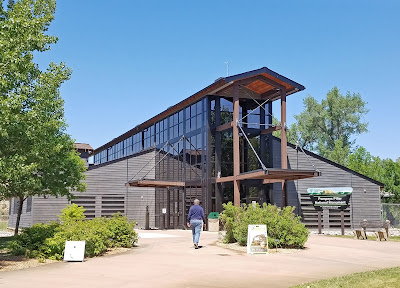Monday, June 14, 2021
 |
| Cottonwoods by the Yellowstone River in Laurel, MT |
 |
Western Heritage Center (1901, by C S Haire as the
Parmly Billings Library in Richardsonian Romanesque style)
is located in Billings, MT |
 |
Moss Mansion (1903, by Henry Janeway Hardenbergh
in English Renaissance style) for Preston Boyd Moss, a
banker who established the utility companies in Billings, MT |
 |
We saw a video about Joseph Medicine Crow
who served in the US Army during WWII,
and earned a Presidential Medal of Freedom |
 |
As a member of the Crow tribe, he was trained
as a warrior, and as a soldier he carried an
eagle feather in his helmet; through his
war experiences, Joe Medicine Crow
accomplished the four "coups" necessary to
become a Crow War Chief: 1) touch an enemy,
2) take an enemy's gun, 3) take an enemy's
horse, and 4) lead a successful "war party" |
 |
| McCormick-Spear Roundup Wagon (c 1920s) |
 |
The Roundup Wagon is what we would call
the Chuck Wagon/a field kitchen |
 |
Saddle of the 1964 World Champion
Steer Wrestler C R Boucher, who
was born in Livingston, MT (KSS) |
 |
An early type of War Bonnet/headdress
earned by a War Chief (KSS) |
 |
War Bonnet/headdress and trailer originally
were worn only by warriors during battle;
now they are worn for ceremonies |
 |
| Detail of how the eagle feathers are attached |
 |
Tragic story of Sacrifice Cliff, where 16
warriors purposely drove themselves over a
cliff to free their tribe from a smallpox epidemic |
 |
| Crow woman's saddle (KSS) |
 |
| Photo of the woman's saddle in use (KSS) |
 |
Two-faced Ghost Dance Doll; while the
First Peoples saw their culture coming to an end
with westward expansion, a spiritual movement
began in hopes that clean living and more
cooperation between the First Nations would
end American expansion and bring peace |
 |
| Billings, MT: Lewis & Clark Historical Marker |
 |
A Range Rider of the Yellowstone (1925,
by Charles C Cristadoro) of actor
William S Hart and his horse "Paint" |
*On 7/25/1806, on the return trip, William Clark and his party came to a rock formation that Clark ascended. He scratched his name and the date along with other names of other early trappers and soldiers, and pictographs and petroglyphs of the First Peoples. Clark named the formation for Sakagawea's child, Jean Baptiste, whom Clark nicknamed "Pomp," calling it Pompy's Tower.* |
| Pompey's Pillar: Lewis & Clark Historical Marker |
 |
Pompey's Pillar was also significant for
the Plains Nations that came here to trade |
 |
| Bust (2006) of Captain William Clark |
 |
| York |
 |
| William Clark |
 |
Sakagawea and Jean Baptiste "Pomp"
at 17 months of age |
 |
| Modern methods were used to create these two dugout canoes |
 |
| Pompey's Pillar |
 |
| Steps to climb to the top of the pillar |
 |
| Clark's "signature" is now protected |
 |
| View west upriver on the Yellowstone River |
 |
| View east downriver |
 |
| A fishing access sign is marred by bullets |
*On 7/26/1806, William Clark and his group reached the mouth of the Bighorn River.* |
| Bighorn River Bridge (1931-1933) |
 |
| Bighorn River curves to the right to meet the Yellowstone River |
 |
Our lunch venue in Hysham, MT, which was surprisingly
clean and modern for being nearly in the middle of nowhere |
 |
Hysham, MY: Yucca Theatre (1931, by David and
James Manning in Mission style) |
*On 7/29/1806, William Clark's party reached the mouth of the Tongue River.* |
Another blocked attempt to see a river confluence:
the Tongue River meets the Yellowstone somewhere
beyond the trees on the right near Miles City, MT |
Again, a review of the return trip, as we will not be retracing our route as did the Corps of Discovery once they regrouped at Reunion Bay.
*On 8/3/1806, on the return trip, William Clark and his group arrived at the Missouri River near the mouth of the Little Knife River.*
*On 8/12/1806, on the return trip, Meriwether Lewis and his group arrived at the Missouri River near the mouth of the Little Knife River for a reunion of the Corps of Discovery.*
*On 8/14/1806, on the return trip, the Corps of Discovery camped at the site of Fort Mandan that had been destroyed by fire,*
*On 9/23/1806, on the return trip, the Corps of Discovery arrived in St Louis after two years, four months and ten days. The expedition has been completed.*
Next: Lewis & Clark Trip Day 39.





































No comments:
Post a Comment